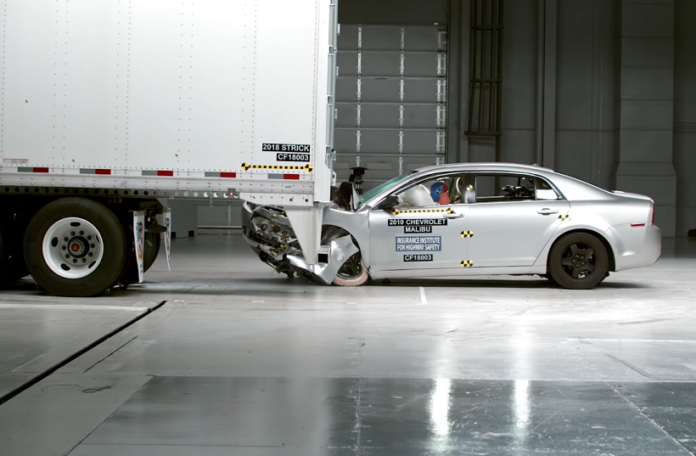[ad_1]

Most new trailers already boast improved underride guards.
Photo: Insurance Institute for Highway Safety
The National Highway Traffic Safety Administration has completed a final rule upgrading requirements for rear underride guards and is turning its attention to side underride guards.
The agency announced on June 30 that it’s updating two Federal Motor Vehicle Safety Standards “to improve protection for drivers and passengers in light vehicles in the event of a rear underride crash,” typically with a highway trailer.
The new rule is a requirement of the trillion-dollar Infrastructure Investment and Jobs Act passed late last year (known widely as the Bipartisan Infrastructure Law). So is increased research and creation of an advisory committee on underride protection. Looking more closely at the underride issue is also part of the Department of Transportation’s 2022 National Roadway Safety Strategy.
A NHTSA document lays out the new rear underride rule as an upgrade of the agency’s safety standards by adopting similar requirements to Transport Canada’s standards for rear impact guards. These standards address the impact on passenger vehicles all the way down to the subcompact range.
The rule amends FMVSS No. 223, “Rear Impact Guards,” and FMVSS No. 224, “Rear Impact Protection.”
“Adopting these standards will require rear impact guards to provide sufficient strength and energy absorption to protect occupants of compact and subcompact passenger cars impacting the rear of trailers at 56 2 kilometers per hour (35 mph),” the agency stated in its rulemaking document. (The previous rules were for 30 mph.) “Upgraded protection will be provided in crashes in which the passenger motor vehicle hits: (a) the center of the rear of the trailer or semitrailer; and, (b) in which 50% of the width of the passenger motor vehicle overlaps the rear of the trailer or semitrailer.”
This rule has not yet been published in the Federal Register. Once it is, NHTSA will set a period of 45 days after publication to accept petitions for reconsideration of this final rule. In addition, a compliance date will be set for two years after publication.
The underride rule has been in the works since 2015. Since then, many trailer makers have voluntarily improved their underride guards. In 2018, the Insurance Institute for Highway Safety awarded its top underride guard rating to eight major trailer manufacturers representing 80% of trailers on the road. To qualify for the IIHS ToughGuard award, trailers must have rear guards that prevent underride of a midsize car in three test modes: full-width, 50% overlap, and 30% overlap. In each test, a midsize car travels at 35 mph toward the back of a parked semitrailer.
More to Come on Improving Truck Trailer Underride Protection
NHTSA also stated in its June 30 announcement that it is implementing other underride provisions mandated by the enormous IIJA infrastructure bill:
- Establishing a federal advisory committee on underride protection, which will complete research on side underride guards for trailers and semi-trailers to assess their effectiveness, feasibility, benefits, costs, and impact on intermodal operations.
- Planning to publish an advance notice of proposed rulemaking on requirements for side underride guards for crashes into the sides of trailers and semi-trailers. This rulemaking also responds to a provision in the IIJA to report the findings of research on side underride guards in a Federal Register notice to seek public comment.
- Improving data collection of underride crashes by recommending inclusion of underride data in State crash data systems and by providing educational materials to state and local police departments on identifying and recording underride crashes.
- Conducting research on rear-impact guard designs that “better protect occupants of passenger vehicles in even more rear underride crash scenarios.”
“NHTSA’s priority is the safety of everyone on our roads,” said NHTSA Administrator Steven Cliff. “This new rule will improve protection for passengers and drivers of passenger vehicles while also meeting a critical mandate from Congress” under the bipartisan IIJA bill.
Underride Inspection Requirements
The federal government also last year started requiring underride guards to be checked as part of the required annual inspection. The Federal Motor Carrier Safety Administration amended the Federal Motor Carrier Safety Regulations to include rear impact guards on the list of items that must be examined as part of the required annual inspection for each commercial motor vehicle. In addition, FMCSA amended the labeling requirements for rear impact guards.
[ad_2]
Source link







